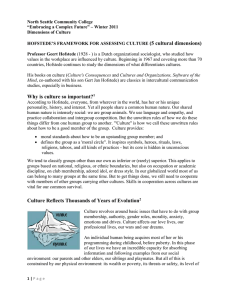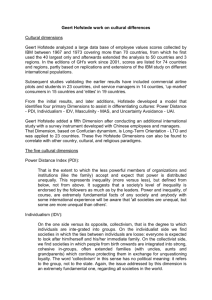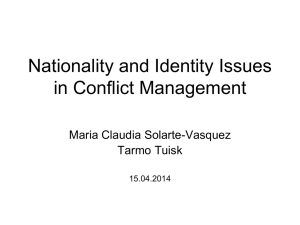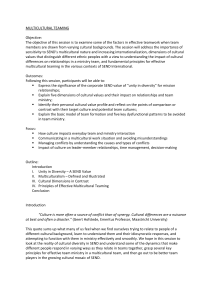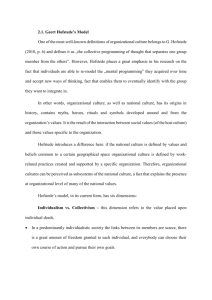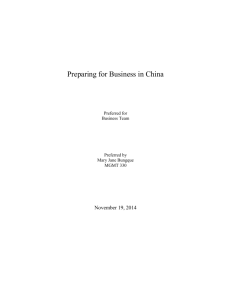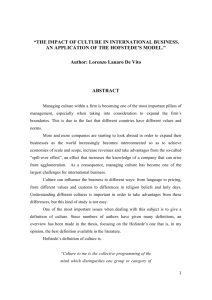culture and cultural dimensions
advertisement
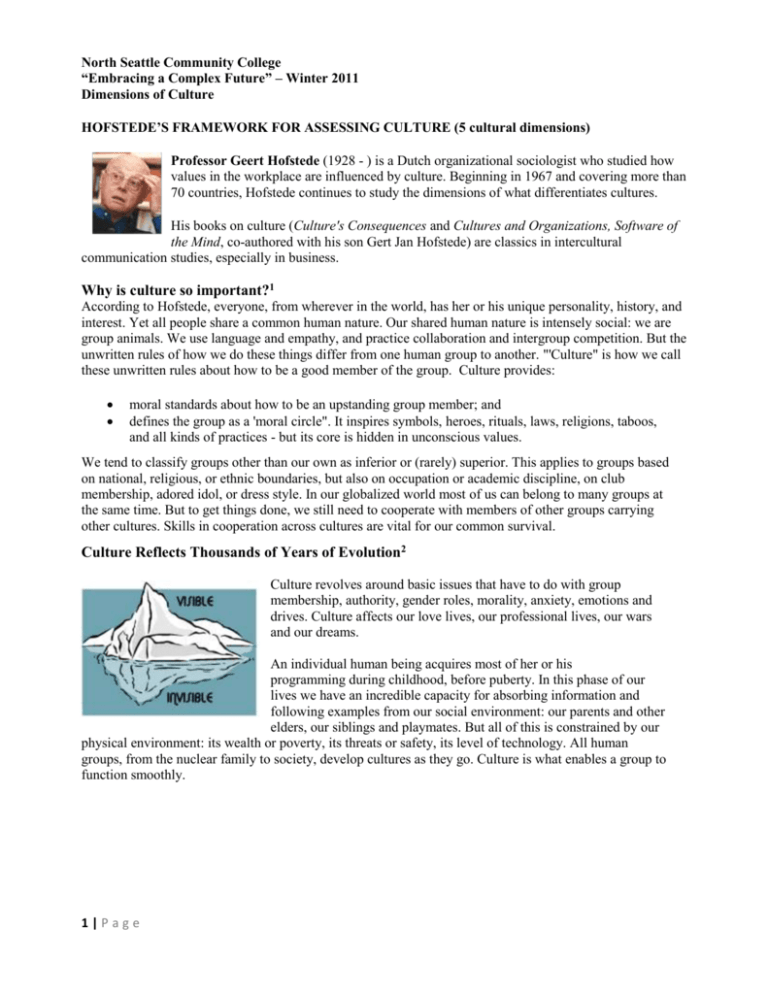
North Seattle Community College “Embracing a Complex Future” – Winter 2011 Dimensions of Culture HOFSTEDE’S FRAMEWORK FOR ASSESSING CULTURE (5 cultural dimensions) Professor Geert Hofstede (1928 - ) is a Dutch organizational sociologist who studied how values in the workplace are influenced by culture. Beginning in 1967 and covering more than 70 countries, Hofstede continues to study the dimensions of what differentiates cultures. His books on culture (Culture's Consequences and Cultures and Organizations, Software of the Mind, co-authored with his son Gert Jan Hofstede) are classics in intercultural communication studies, especially in business. Why is culture so important?1 According to Hofstede, everyone, from wherever in the world, has her or his unique personality, history, and interest. Yet all people share a common human nature. Our shared human nature is intensely social: we are group animals. We use language and empathy, and practice collaboration and intergroup competition. But the unwritten rules of how we do these things differ from one human group to another. "'Culture" is how we call these unwritten rules about how to be a good member of the group. Culture provides: moral standards about how to be an upstanding group member; and defines the group as a 'moral circle". It inspires symbols, heroes, rituals, laws, religions, taboos, and all kinds of practices - but its core is hidden in unconscious values. We tend to classify groups other than our own as inferior or (rarely) superior. This applies to groups based on national, religious, or ethnic boundaries, but also on occupation or academic discipline, on club membership, adored idol, or dress style. In our globalized world most of us can belong to many groups at the same time. But to get things done, we still need to cooperate with members of other groups carrying other cultures. Skills in cooperation across cultures are vital for our common survival. Culture Reflects Thousands of Years of Evolution2 Culture revolves around basic issues that have to do with group membership, authority, gender roles, morality, anxiety, emotions and drives. Culture affects our love lives, our professional lives, our wars and our dreams. An individual human being acquires most of her or his programming during childhood, before puberty. In this phase of our lives we have an incredible capacity for absorbing information and following examples from our social environment: our parents and other elders, our siblings and playmates. But all of this is constrained by our physical environment: its wealth or poverty, its threats or safety, its level of technology. All human groups, from the nuclear family to society, develop cultures as they go. Culture is what enables a group to function smoothly. 1|Page Hofstede’s Five Dimensions of Culture3 Cultural Dimension #1: Individualism (IDV) This refers to the strength of the ties people have to others within the community. A high IDV score indicates a loose connection with people. In countries with a high IDV score there is a lack of interpersonal connection and little sharing of responsibility, beyond family and perhaps a few close friends. A society with a low IDV score would have strong group cohesion, and there would be a large amount of loyalty and respect for members of the group. The group itself is also larger and people take more responsibility for each other's well being. IDV High IDV Characteristics High valuation on people's time and their need for freedom. An enjoyment of challenges, and an expectation of rewards for hard work. Cross Cultural Tips Acknowledge accomplishments. Don't ask for too much personal information. Encourage debate and expression of own ideas. Respect for privacy. Low IDV Emphasis on building skills and becoming masters of something. Work for rewards that come naturally. Harmony more important than honesty. Show respect for age and wisdom. Suppress feelings and emotions to work in harmony. Respect traditions and introduce change slowly. Cultural Question: Do you think the United States has a high or low degree of Individualism? Why? What examples can you give? How do you see this cultural value played out in your workplace or in your immediate environment? What examples can you give? Cultural Dimension #2: Masculinity (MAS) This refers to how much a society sticks with, and values, traditional male and female roles. High MAS scores are found in countries where men are expected to be tough, to be the provider, to be assertive and to be strong. If women work outside the home, they have separate professions from men. Low MAS scores do not reverse the gender roles but mean that the gender roles are simply blurred. You see women and men working together equally across many professions. Men are allowed to be sensitive and women can work hard for professional success. MAS Characteristics Cross Cultural Tips Men are masculine and women are feminine. Be aware that people may expect male and female roles to be distinct. High MAS There is a well defined distinction between men's work and women's work. Advise men to avoid discussing emotions or making emotionally-based decisions or arguments. Low MAS A woman can do anything a man Avoid an "old boys' club" mentality. 2|Page can do. Powerful and successful women are admired and respected. Ensure job design and practices are not discriminatory to either gender. Treat men and women equally. Cultural Question: Do you think the United States places a high or low degree on Masculinity? What examples can you give? How do you see this cultural value played out in your workplace or in your immediate environment? Cultural Dimension #3: Long Term Orientation (LTO) This refers to how much society values long-standing – as opposed to short term – traditions and values. In countries with a high LTO score, following through on social obligations and avoiding "loss of face" are considered very important. LTO High LTO Low LTO Characteristics Cross Cultural Tips Family is the basis of society. Parents and men have more authority than young people and women. Strong work ethic. High value placed on education and training. Show respect for traditions. Do not display extravagance or act frivolously. Reward perseverance, loyalty, and commitment. Promotion of equality. High degree of creativity and individualism. Treat others as you would like to be treated. Self-actualization is sought. Expect to live by the same standards and rules you create. Be respectful of others. Do not hesitate to introduce necessary changes. Avoid doing anything that would cause another to "lose face". Cultural Question: Do you think the United States values long standing traditions or not? What examples support your answer? How do you see this cultural value played out in your workplace or in your immediate environment? Cultural Dimension #4: Power/Distance (PD) This refers to the degree of inequality that exists – and is accepted as normal – among people with and without power. A high PD score indicates that society accepts an unequal distribution of power and people understand "their place" in the system. Low PD means that power is shared and well dispersed. It also means that society members view themselves as equals. PD High PD 3|Page Characteristics Centralized organizations Strong hierarchies Large gaps in compensation, authority, and respect Cross Cultural Tips Acknowledge a leader's power. Be aware that you may need to go to the top for answers. Low PD Flatter organizations. Supervisors and employees are considered almost as equals. Use teamwork. Involve as many people as possible in decision making. Cultural Question: Do you think in the United States that the less powerful members in organizations and institutions accept the inequity of power or do you believe that in the United States most people want to see a more equal distribution of power? What examples support your answer? Cultural Dimension #4: Uncertainty/Avoidance Index (UAI) This relates to the degree of anxiety society members feel when in uncertain or unknown situations. High UAI-scoring nations try to avoid ambiguous (unclear) situations whenever possible. They are governed by a high degree of rules and order and they seek a collective or one "truth". Low UAI scores indicate the society enjoys creative events and values differences. There are very few rules and people are encouraged to discover their own truth. UAI High UAI Low UAI Characteristics Cross Cultural Tips Very formal business conduct with lots of rules and policies. Need and expect structure. Sense of nervousness spurns high levels of emotion and expression. Differences are avoided. Be clear and concise about your expectations. Informal business attitude. More concern with long term strategy than what is happening on a daily basis. Do not impose rules or structure unnecessarily. Express curiosity when you discover differences. Plan and prepare, communicate often and early, provide detailed plans and focus on the tactical aspects of a job or project. Accepting of change and risk. Cultural Question: How do you think the United States rates in this cultural dimension? High or low? What examples support your answer? How do you see this cultural value played out in your workplace or in your immediate environment? ______________________________________________________________________________ 1 Adapted from: http://www.geerthofstede.nl/index.aspx Adapted from: http://www.geerthofstede.nl/culture.aspx 3 Adapted from: http://www.mindtools.com/pages/article/newLDR_66.htm 2 4|Page North Seattle Community College Embracing a Complex Future, Winter 2011 Hofstede’s Cultural Dimension Scores for the United States Individualism According to Hofstede’s researchThere are only seven (7) countries that rate Individualism (IDV) as their highest Dimension: USA (91), Australia (90), England (89), Netherlands and Canada (80), and Italy (76). The high Individualism (IDV) ranking for the United States means that our society has a more individualistic attitude. In the United States as a culture, we currently perceive our bonds with others more loosely. The U.S. population, as a whole, is more self-reliant and looks out for themselves and their close family members. Masculinity: According to Hofstede’s research The next highest Cultural Dimension in the United States is Masculinity (MAS) with a ranking of 62, compared with a world average of 50. This indicates that in the United States, we experience a higher degree of gender differentiation of roles. The male dominates a significant portion of the society and power structure. This situation generates a female population that has become more assertive and competitive, with women shifting toward the male role model and away from their female role. Long Term Orientation: According to Hofstede’s research The United States has the lowest ranking at 29, compared to the world average of 45. This low LTO ranking indicates a belief in meeting its present obligations, allows for and appreciates cultural traditions and differences, and accepts change. Power/Distance: According to Hofstede’s research The next lowest ranking Dimension for the United States is Power Distance (PDI) at 40, compared to the world average of 55. This indicates a greater equality between societal levels, including government, organizations, and even within families. This orientation reinforces a cooperative interaction across power levels and creates a more stable cultural environment. Uncertainty/Avoidance: According to Hofstede’s researchThe last dimension for the United States is Uncertainty Avoidance (UAI), with a ranking of 46, compared to the world average of 64. A low ranking in the Uncertainty Avoidance Dimension indicates a society has fewer rules and does not attempt to control all outcomes and results. It also has a greater level of tolerance for a variety of ideas, thoughts, and beliefs. Are you curious to see how other cultures compare to the United States? For a list of scores by cultural dimension for another country in comparison to the United States, visit Geert Hofsted’s website at http://www.geert-hofstede.com/ 5|Page 6|Page
